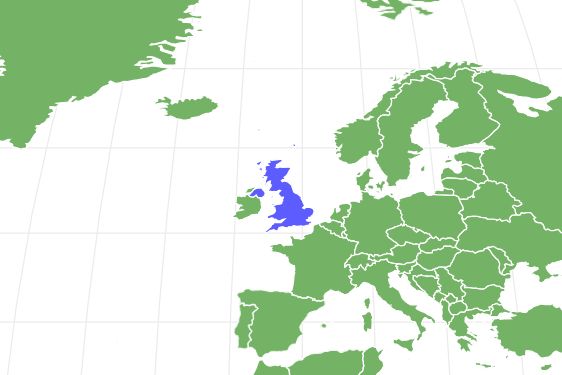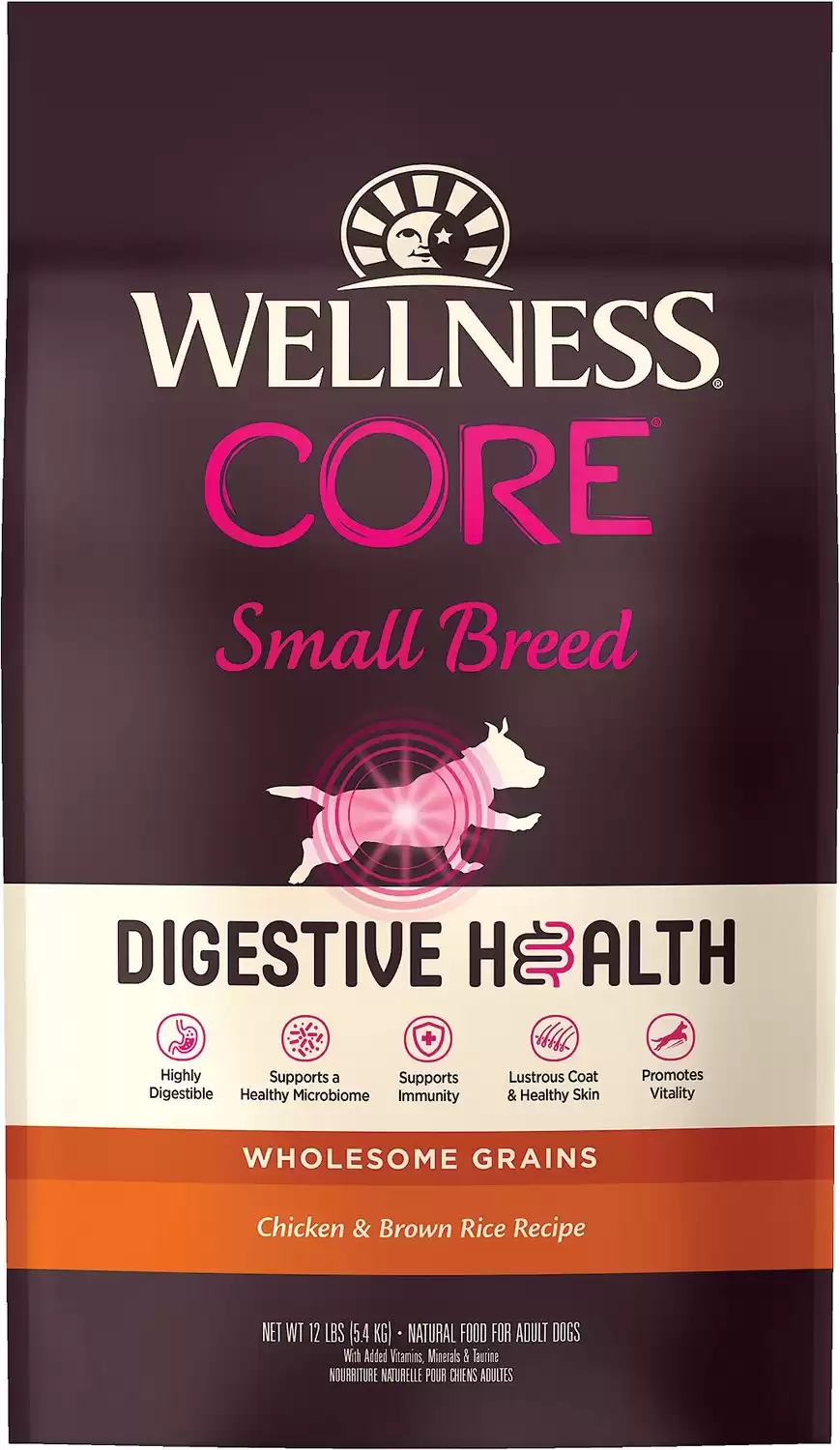Bedlington Terrier
Canis Lupus
The city of Bedlington, England named their soccer team the Terriers after this breed!
Advertisement
Bedlington Terrier Scientific Classification
- Kingdom
- Animalia
- Phylum
- Chordata
- Class
- Mammalia
- Order
- Carnivora
- Family
- Canidae
- Genus
- Canis
- Scientific Name
- Canis Lupus
Read our Complete Guide to Classification of Animals.
Bedlington Terrier Conservation Status
Bedlington Terrier Facts
- Fun Fact
- The city of Bedlington, England named their soccer team the Terriers after this breed!
- Temperament
- Bold, confident and playful
- Training
- Should be trained from an early age due to their hyperactive nature
- Diet
- Omnivore
- Average Litter Size
- 4
- Common Name
- Bedlington Terrier
- Slogan
- Highly active and intelligent dogs!
- Group
- Terrier
Bedlington Terrier as a Pet:
- General Health
- Energy Level
- Shedability
- Trainability
- Intelligence
- Tendency to Chew
- Size
- Family and kid friendliness
- Yappiness / Barking
- Moderate
- Hypoallergenic
- Yes
- Separation Anxiety
- Moderate
- Preferred Temperature
- Average climate
- Exercise Needs
- Moderate
- Friendly With Other Dogs
- Moderate
- Pure bred cost to own
- $1500-$2300
- Dog group
- Terrier
- Male weight
- 17-23 lbs
- Female weight
- 17-23 lbs
This post may contain affiliate links to our partners like Chewy, Amazon, and others. Purchasing through these helps us further the A-Z Animals mission to educate about the world's species.
View all of the Bedlington Terrier images!
The build of a Bedlington Terrier consists of an arched back, pear-shaped head, and a thin, curvy tail. Since they are so curvy in appearance, it is speculated that some type of sighthound (most likely a Whippet) is somewhere within the family tree of the Bedlington Terrier.
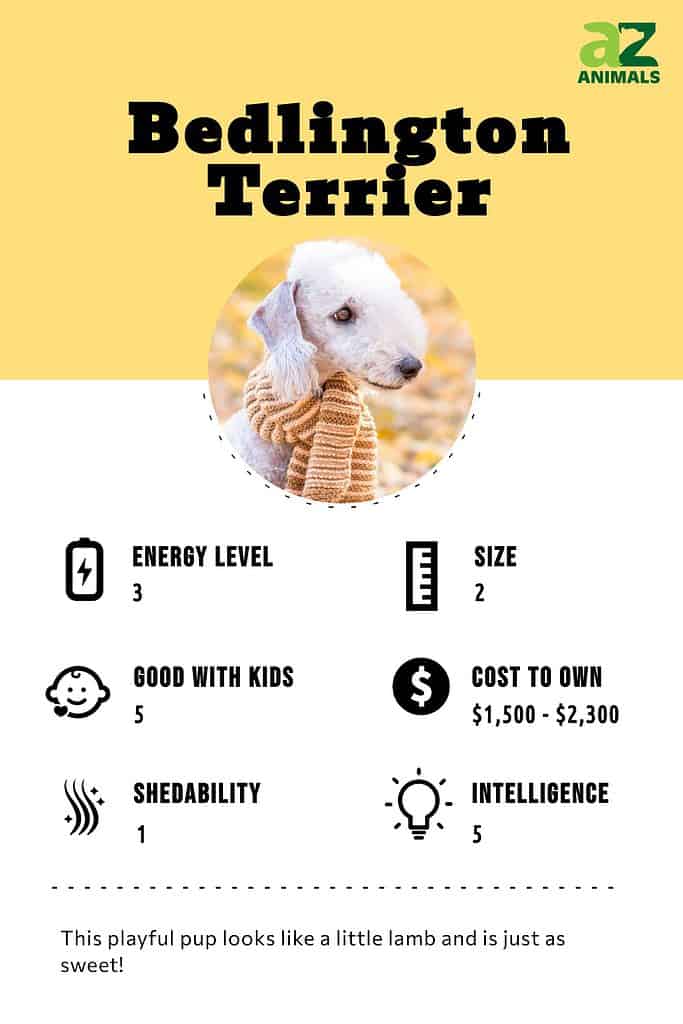
Evolution
Bedlington Terriers are compact, yet energetic little dogs. Originating from Bedlington, England, they were originally used in hunting rats, mice, and other small animals in coal mines, factories, and other similar environments. The earliest reference to the Bedlington Terrier is in 1825 when a terrier named Piper was bred and used to hunt badgers. Piper was so tenacious that local workmen became fond of the breed and began using them for pit fighting. While the dog was used in pit fighting, their sweet and lovable temperaments soon found them taking on roles as beloved family companions.
See all of our expert product reviews.
Appearance and Disposition
Their hypoallergenic curly coats are reminiscent of sheep’s wool, while their compact, uniquely shaped heads make them distinctive in appearance. Since their designation as a breed, these plucky little terriers have been used in racing, hunting, and other dog sports. This highly intelligent, active, athletic, loving, non-shedding dog is an excellent choice for families with an active lifestyle.
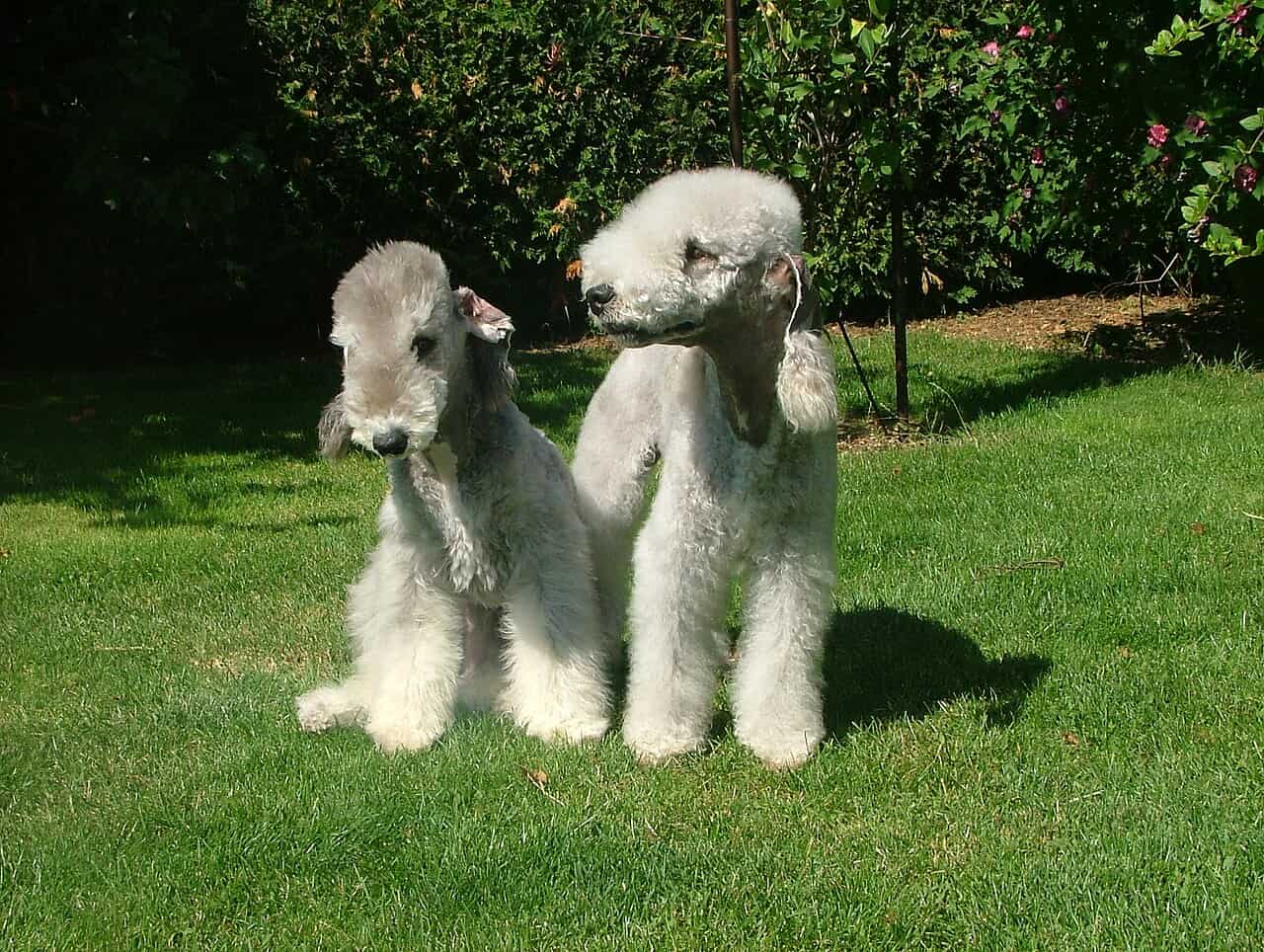
Bedlington Terriers are calmer and better with children than other terriers.
©David Owsiany, CC BY-SA 4.0, via Wikimedia Commons – License
3 Pros and Cons of Owning a Bedlington Terrier
| Pros! | Cons! |
| Their small size makes them versatile: Since Bedlington Terriers are typically between 17 and 23 pounds, they are able to thrive in a number of different living situations. | Their coats require a lot of grooming: While their coats virtually don’t shed, they do grow quickly. Most Bedlington Terriers need to be professionally clipped once every two months. In addition to this, their coat needs to be brushed or combed at least twice a week. |
| Hypoallergenic and low shedding: Since their curly coats are a mixture of soft and harsh hair, Bedlington Terriers don’t shed that much. This makes them the ideal dog for owners who don’t want to deal with dog hair or who have allergies. | They can be loud: Like many terriers, they can bark a lot. This means they may not be ideal living companions in an apartment. |
| Playful, yet generally calmer than other terriers: With a Bedlington Terrier, you get the same lovable personality traits that are inherent in other types of terriers, but with a less rowdy energy level. | They are stubborn: While Bedlington Terriers are smart and eager to please, they do tend to have that stubborn terrier streak. This can make it somewhat difficult to train them. |
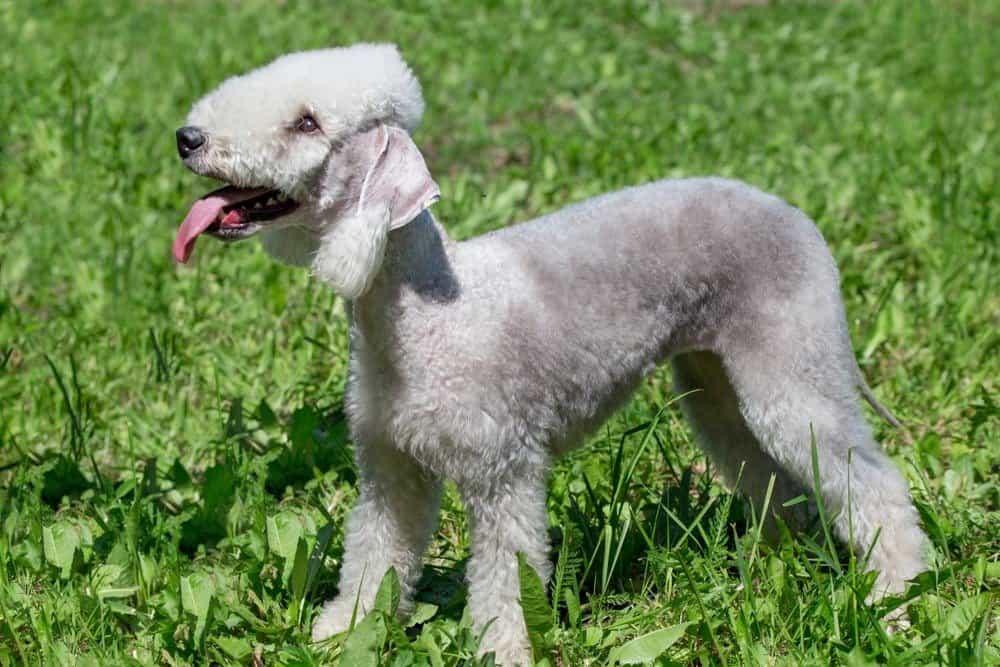
Bedlington Terriers are hypoallergenic pets and great for those with allergies.
©Tikhomirov Sergey/Shutterstock.com
Health and Entertainment for your Bedlington Terrier
See all of our expert product reviews.
Size and Weight
The Bedlington Terrier is a small-sized short hair dog with an average height of 16 to 18 inches for males and 15 to 17 inches for females. Both males and females tend to weigh between 17 and 23 pounds when fully grown. Bedlington Terrier puppies usually weigh around three pounds at the age of two months. Puppies generally reach their adult weight and size at nine months of age.
| Height (male): | 16 to 18 inches |
| Height (female): | 15 to 17 inches |
| Weight (male): | 17 to 23 pounds |
| Weight (female): | 17 to 23 pounds |
Common Health Issues
Like every dog breed, Bedlington Terriers have a few health issues that tend to be common within the breed. Many breeders have their breeding stock tested for these conditions. These problems include:
- Copper Toxicosis
- Progressive Retinal Atrophy (PRA)
- Exocrine Pancreatic Insufficiency
- Hyperadrenocorticism (Cushing’s)
Copper Toxicosis is a genetic disorder (although it can also develop non-genetically) that causes copper to accumulate within the liver and bloodstream. This can lead to the dog experiencing liver failure. This potentially fatal disease usually appears between the ages of two and four.
Bedlington Terriers are also more prone to developing a variety of eye conditions. Among these is Progressive Retinal Atrophy (PRA). This is an inherited condition that leads to blindness. While there is no cure for this condition, it isn’t painful. It just means that your dog may develop night blindness between three and five years of age. It also means that your dog will become blind.
Exocrine Pancreatic Insufficiency is a disorder that causes the dog’s pancreas to develop too few of the digestive enzymes that are used to digest food and absorb nutrients. This leads to the dog losing weight, having skin problems, and having frequent bouts of diarrhea. It is easily treated with dietary supplements.
Hyperadrenocorticism (also called Cushing’s) is a condition that is more likely to be found in Bedlington Terriers than in other dogs. It causes the adrenal glands to malfunction and produce too many steroid hormones. This condition can be treated with medications.

Bedlington Terriers are both plucky and gentle.
©Elf at English Wikipedia, CC BY-SA 3.0, via Wikimedia Commons – License
Temperament
Bedlington Terriers are intelligent, plucky little dogs who are also gentle and mild in behavior. While they enjoy getting lots of exercise, they also enjoy hanging out on the couch with their owners. Their gentle personality and active nature make them a good choice for active families who want the best of both worlds when it comes to their dog’s personality. Originally bred in Bedlington, England in the 1800s, the Bedlington Terrier was originally used in hunting vermin. It was also used for dog racing and other dog sports.
The Bedlington Terrier is part of the Terrier Group. As such, they tend to have the same spunky and independent personality traits as other terriers. While they enjoy being active and are very athletic dogs, their behavior is usually calmer than other terriers included in this group.
How to Take Care of a Bedlington Terrier
Potential pet owners searching for how to care for a new dog, especially Bedlington Terrier puppies, will need to consider a variety of factors. Taking care of a Bedlington Terrier, whether it be a puppy or a rescue, will mean taking into consideration grooming requirements, potential health issues, the dog’s size, a family’s lifestyle, the dog’s temperament, and many other needs that the puppy or dog will have.

Bedlington Terriers rarely shed but their fur grows fast and needs trimming often.
©SubertT/Shutterstock.com
The Best Dog Food for Bedlington Terriers
Just like all dog breeds, Bedlington Terriers have individual dietary needs. Smaller dog breeds need different diets than large dogs do. Energetic breeds also have special needs. To ensure that your Bedlington Terrier lives a healthy life, it needs to have a balanced diet. One way to be sure that this happens is to feed high-quality dog food. Dry dog food is considered to be appropriate for puppies and adult dogs.
Because the breed experiences such a unique set of potential health conditions, discuss your dog’s diet at regular appointments.
Diet for Bedlington Terrier Puppies: Bedlington Terrier puppies need to be fed four meals a day at first. As the puppy grows older, he or she will be able to eat just three times a day. The dog food you choose should be specifically formulated for puppies, with plenty of calcium and phosphorus.
Diet for Adult Bedlington Terriers: Adult Bedlington Terriers should be fed just twice a day. If your dog is active and enjoys frequent heavy exercise, their portion at meals will be more than if the dog is inactive. Supplements such as glucosamine, omega-3 fatty acids, probiotics, antioxidants, and digestive enzymes can also be fed to your dog.
At A-Z Animals, we find that the best dog food for Bedlington Terriers is Wellness CORE Digestive Health Small Breed Dry Dog Food with Wholesome Grains.
To help with Bedlington Terriers’ tendency for Exocrine Pancreatic Insufficiency, this kibble is coated with probiotics and supplements their diet with the digestive enzymes they can lose to the condition. The wholesome chicken and turkey recipe contains taurine, which benefits the eyes and vision.
Check Chewy and Amazon for this product.
- Chicken and brown rice recipe for small breeds
- Contains fiber-rich superfoods for healthy digestion
- Antioxidants and prebiotics for healthy immune system
Maintenance and Grooming
While this breed doesn’t shed a lot, Bedlington Terriers have extensive grooming needs. They will need to have their hair professionally clipped (or you can purchase the tools and learn how to do it yourself). In addition to this, they need to be brushed or combed at least twice a week. If you choose to learn how to clip your dog’s hair on your own, you will need to purchase electric clippers and scissors. You will also need to trim your dog’s nails regularly.
Nutrition
The Bedlington terrier should do perfectly fine on any high-quality dog food whether it is a commercially manufactured or home-prepared mix. Any diet should, however, be appropriate to the age of the dog such as puppy, adult, and senior. Some dogs are just naturally prone to being overweight, so it’s important to consider their calorie consumption and weight gain. Treats are important to aid in training, but giving too many can cause health problems. Check with your vet for any additional information.

Bedlington Terriers are highly intelligent and relatively easy to train.
©Ermolaev Alexander/Shutterstock.com
Training
Bedlington Terriers are relatively easy to train. They are eager to please and highly intelligent. However, they do tend to get bored easily, so you will need to work to keep their attention. They can also be somewhat stubborn.
Exercise
Bedlington Terriers are small in size, so can do well in apartments or smaller living spaces as long as they are given an adequate amount of exercise. These dogs can be pretty energetic, meaning you will need to take them for long walks or runs regularly. Games of fetch are also an excellent way to help the Bedlington Terrier to get plenty of exercise. You should always keep your Bedlington Terrier in a fenced-in yard or on a leash while in open spaces. This is because they were bred for hunting small animals and will typically start to chase one once they see it.
Bedlington Terrier Puppies
Since Bedlington Terrier puppies are small dogs, you will need to be sure that you are feeding them at least four times a day when they first come home. You will gradually reduce this down to three and then two times a day. Other than that, you will need to work on house training, socialization, and basic obedience training for your Bedlington Terrier puppy. Once your puppy is old enough and has gone through obedience training, you may want to get it involved in dog sports such as racing or agility.
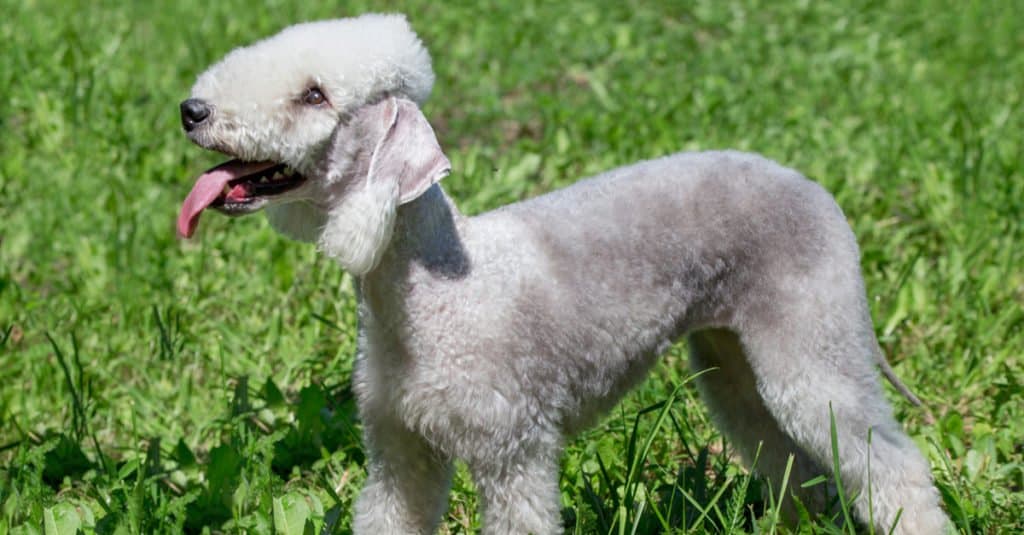
Bedlington Terrier puppies are great with children. They are playful and friendly.
©Tikhomirov Sergey/Shutterstock.com
Bedlington Terriers and Children
The gentle demeanor of the Bedlington Terrier makes it an ideal family dog for families with children who are gentle and respectful towards the dog and its space. Families with small children may want to hold off on getting a Bedlington Terrier until the child is older.
Dogs Similar to Bedlington Terriers
Dogs that are similar to the Bedlington Terrier breed are the Soft Coated Wheaten Terrier, the Kerry Blue Terrier, and the Whippet.
- Norfolk Terrier – Norfolk Terriers are small, plucky, playful, and intelligent. If you’re looking for a watchdog with a lot of energy that can be great with kids, the Norfolk Terrier could be a good choice for you.
- Airedale Terrier – If you’d like a larger version of a terrier breed that is also hypoallergenic, the Airedale Terrier could be right for you. Airedale Terriers are great with kids and rarely shed.
- Whippet – While not a terrier, the Whippet is believed to have been used to develop the Bedlington Terrier breed. Much like Bedlington Terriers, Whippets are relatively laid back and affectionate that enjoy lots of exercise.
Famous Bedlington Terriers
Film actor Boris Karloff owned and raised Bedlington Terriers when he wasn’t working on his films. In addition to this, the famed Rockefeller family owned and bred Bedlington Terriers in the 1940s.
Popular Names for Bedlington Terriers
- Mickey
- Frankie
- Beau
- Chance
- Marley
- Dixie
- Paisley
- Mia
- Maggie
- Daisy
Bedlington Terrier FAQs (Frequently Asked Questions)
Are Bedlington Terriers herbivores, carnivores, or omnivores?
Bedlington Terriers are Omnivores, meaning they eat both plants and other animals.
What Kingdom do Bedlington Terriers belong to?
Bedlington Terriers belong to the Kingdom Animalia.
What class do Bedlington Terriers belong to?
Bedlington Terriers belong to the class Mammalia.
What phylum to Bedlington Terriers belong to?
Bedlington Terriers belong to the phylum Chordata.
What family do Bedlington Terriers belong to?
Bedlington Terriers belong to the family Canidae.
What order do Bedlington Terriers belong to?
Bedlington Terriers belong to the order Carnivora.
What genus do Bedlington Terriers belong to?
Bedlington Terriers belong to the genus Canis.
What type of covering do Bedlington Terriers have?
Bedlington Terriers are covered in Hair.
How many babies do Bedlington Terriers have?
The average number of babies a Bedlington Terrier has is 4.
What is an interesting fact about Bedlington Terriers?
Bedlington Terriers are highly active and intelligent dogs!
What is the scientific name for the Bedlington Terrier?
The scientific name for the Bedlington Terrier is Canis Lupus.
How much does a Bedlington Terrier cost?
The price of a Bedlington Terrier will depend on the breeder or rescue that you purchase or adopt your puppy or adult dog from. The average purchase price from a breeder is $1500. However, the price can be as high as $2300. Breeders selling show dog quality puppies will charge more than breeders with pet quality puppies. The potential price of veterinary care for a Bedlington Terrier averages $3700. You will also need to factor in the cost of food, training, grooming, and dog boarding.
Do Bedlington Terriers make good pets?
Bedlington Terriers make excellent pets. They are a great mixture of active and cuddly. They also don’t shed a lot and are hypoallergenic. If you want a hypoallergenic pet that enjoys going for walks and snuggling on the couch, a Bedlington Terrier could be right for you.
Are Bedlington Terriers good with kids?
Bedlington Terriers are usually good with kids, especially if they are raised with them from puppyhood. However, if you have small children who are going to be rough with the dog, it is recommended that you wait until your children are older before getting a Bedlington Terrier.
What is the average lifespan of a Bedlington Terrier?
The average lifespan of a Bedlington Terrier is 12 to 14 years.
Do Bedlington Terriers bark a lot?
Bedlington Terriers can bark a lot if they are allowed to.
Can Bedlington Terriers be left alone?
Bedlington Terriers can be left alone, but they shouldn’t be left alone for long periods of time.
Thank you for reading! Have some feedback for us? Contact the AZ Animals editorial team.
Sources
- akc.org, Available here: https://www.akc.org/dog-breeds/bedlington-terrier/
- bedlingtonamerica.com, Available here: https://www.bedlingtonamerica.com/breed-information/meet-the-bedlington/
- ukcdogs.com, Available here: https://www.ukcdogs.com/bedlington-terrier
- be.chewy.com, Available here: https://be.chewy.com/bedlington-terrier/
- dogtime.com, Available here: https://dogtime.com/dog-breeds/bedlington-terrier#/slide/1
- yourpurebredpuppy.com, Available here: https://www.yourpurebredpuppy.com/reviews/bedlingtonterriers.html
- smalldogplace.com, Available here: https://www.smalldogplace.com/bedlington-terrier.html
- hypoallergenicdog.net, Available here: https://hypoallergenicdog.net/are-bedlington-terriers-hypoallergenic-dogs/

